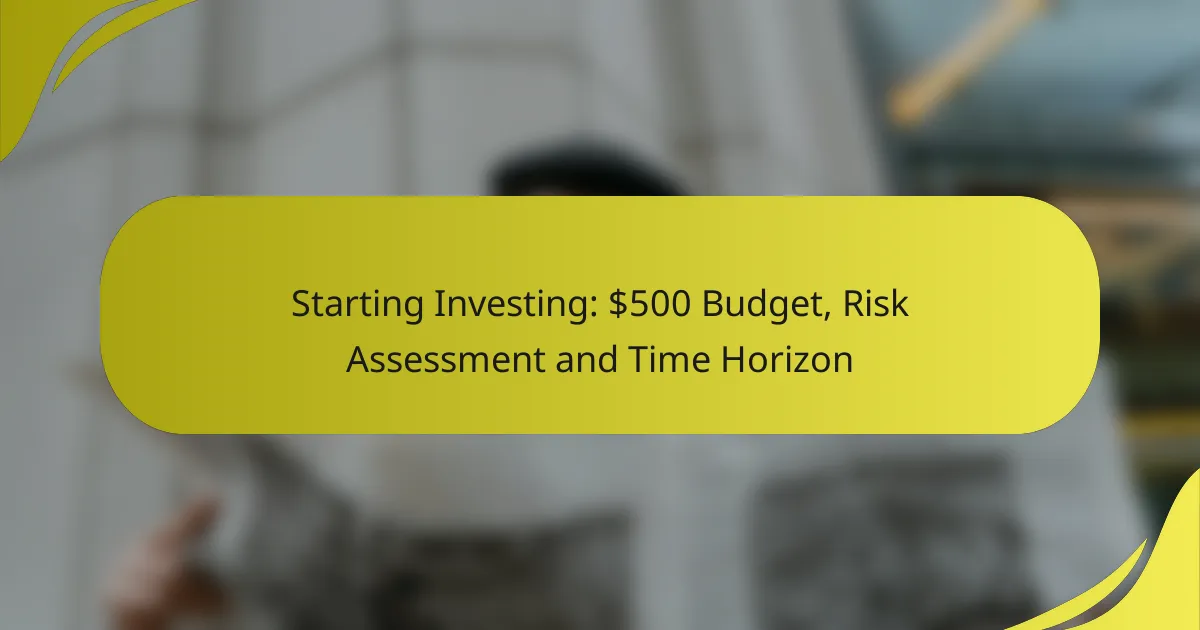Starting to invest with a $500 budget is entirely feasible and can set the foundation for future financial growth. By focusing on low-cost investment options, you can diversify your portfolio while managing risks effectively. Understanding your risk tolerance and time horizon is crucial to making informed decisions that align with your financial goals.

How to start investing with a $500 budget?
Starting to invest with a $500 budget is entirely feasible and can set the foundation for future financial growth. Focus on low-cost investment options that allow you to diversify your portfolio without requiring a large initial outlay.
Micro-investing apps like Acorns
Micro-investing apps, such as Acorns, enable you to invest small amounts of money, often by rounding up your purchases to the nearest dollar and investing the spare change. This approach is ideal for beginners who want to start investing without a significant commitment.
With Acorns, you can set up automatic contributions, making it easier to build your investment over time. The app typically charges a monthly fee, which is relatively low, but ensure that the fee does not outweigh your investment returns.
Robo-advisors such as Betterment
Robo-advisors like Betterment provide automated investment management services tailored to your financial goals and risk tolerance. They typically require low minimum investments and charge a small management fee, making them accessible for those starting with $500.
Betterment creates a diversified portfolio for you, investing in low-cost ETFs based on your risk profile. This hands-off approach is suitable for individuals who prefer not to manage their investments actively.
Exchange-traded funds (ETFs)
Exchange-traded funds (ETFs) are investment funds that trade on stock exchanges, similar to individual stocks. They offer a way to invest in a diversified portfolio of assets with relatively low fees, making them a smart choice for those with a limited budget.
With $500, you can purchase shares of various ETFs that track different sectors or indices. Look for funds with low expense ratios to maximize your returns. Keep in mind that while ETFs can provide diversification, they still carry market risks, so assess your risk tolerance before investing.

What are the risks associated with investing?
Investing involves several risks that can affect the value of your investments. Understanding these risks is crucial for making informed decisions and managing your investment strategy effectively.
Market volatility
Market volatility refers to the fluctuations in the price of securities over time. These changes can be influenced by various factors, including economic indicators, political events, and market sentiment.
Investors should be prepared for both upward and downward movements in their investment values. For example, a stock might rise 10% one month and fall 15% the next, highlighting the unpredictable nature of the market.
To mitigate the impact of market volatility, consider diversifying your portfolio across different asset classes and sectors. This can help spread risk and reduce the overall impact of market swings on your investments.
Liquidity risk
Liquidity risk is the possibility that an investor may not be able to quickly buy or sell an asset without significantly affecting its price. This risk is particularly relevant for investments in less-traded securities or real estate.
For instance, if you own shares in a small company, you might find it challenging to sell those shares quickly without lowering the price. To manage liquidity risk, consider investing in more liquid assets, such as large-cap stocks or exchange-traded funds (ETFs), which typically have higher trading volumes.
Credit risk
Credit risk is the risk that a borrower may default on their obligations, leading to potential losses for the lender or investor. This risk is particularly relevant in fixed-income investments, such as bonds.
For example, if you invest in corporate bonds and the issuing company faces financial difficulties, you may not receive your interest payments or the return of your principal. To minimize credit risk, consider investing in bonds with higher credit ratings or diversifying your bond holdings across different issuers.

How to assess your risk tolerance?
Assessing your risk tolerance involves understanding how much risk you are willing to take with your investments. It is influenced by factors such as your financial situation, investment goals, and emotional comfort with market fluctuations.
Risk assessment questionnaires
Risk assessment questionnaires are tools designed to help you evaluate your risk tolerance. These questionnaires typically ask about your investment experience, financial situation, and how you would react to market downturns.
Many financial institutions and investment platforms offer these questionnaires for free. Completing one can provide you with a clearer picture of your risk profile, which can guide your investment choices.
Understanding personal financial goals
Your personal financial goals play a crucial role in determining your risk tolerance. Consider what you are investing for, whether it’s retirement, buying a home, or funding education. Each goal may require a different approach to risk.
For example, if you are saving for a long-term goal like retirement, you might be more comfortable taking on higher risk. Conversely, if you need to access your funds in the short term, a conservative approach may be more suitable. Regularly reviewing and adjusting your goals can help ensure your investment strategy aligns with your risk tolerance.

What is the importance of time horizon in investing?
The time horizon in investing refers to the duration an investor expects to hold an investment before needing to access the funds. Understanding your time horizon helps determine the appropriate investment strategy, risk tolerance, and asset allocation, ultimately influencing potential returns.
Short-term vs long-term investments
Short-term investments are typically held for a period of less than three years, focusing on quick returns with lower risk. Common examples include savings accounts, money market funds, and short-term bonds. In contrast, long-term investments are held for several years or decades, allowing for greater growth potential through assets like stocks and real estate.
Investors should consider their financial goals and liquidity needs when deciding between short-term and long-term investments. For instance, if you need access to cash soon, short-term options may be more suitable, while long-term investments can benefit from compounding returns over time.
Impact on investment strategy
Your time horizon significantly impacts your investment strategy, influencing how much risk you can take. Longer time horizons generally allow for more aggressive strategies, as there is time to recover from market fluctuations. Conversely, shorter horizons may necessitate a conservative approach to protect capital.
For example, if you plan to invest for retirement in 30 years, you might allocate a larger portion of your portfolio to stocks, which can offer higher returns over time. However, if you are saving for a home purchase in two years, you might prioritize safer investments like bonds or cash equivalents to ensure your funds are available when needed.

How to create an investment plan with $500?
Creating an investment plan with $500 involves setting clear financial goals, diversifying your investments, and establishing a strategy for regular contributions. This approach helps maximize your returns while managing risk effectively.
Setting clear financial goals
Defining your financial goals is crucial when investing $500. Consider whether you are saving for short-term needs, like a vacation, or long-term objectives, such as retirement. Clear goals will guide your investment choices and help you determine your risk tolerance.
For example, if your goal is to grow your investment over five years for a significant purchase, you might opt for a balanced portfolio that includes stocks and bonds. Conversely, if you need the money within a year, a more conservative approach with cash or short-term bonds may be appropriate.
Diversifying investments
Diversification is key to managing risk in your investment plan. With $500, you can spread your investment across various asset classes, such as stocks, bonds, and ETFs. This reduces the impact of poor performance in any single investment.
Consider using low-cost index funds or ETFs to achieve diversification without needing a large capital outlay. For instance, investing in a total market ETF allows you to own a small piece of many companies, which can mitigate risk compared to investing in individual stocks.
Regular contributions strategy
Establishing a strategy for regular contributions can significantly enhance your investment growth over time. Even small, consistent contributions can compound and lead to substantial returns. Aim to invest a portion of your income regularly, such as monthly or quarterly.
For example, if you add $50 each month to your initial $500 investment, you will increase your total investment over time, benefiting from dollar-cost averaging. This approach helps you buy more shares when prices are low and fewer when prices are high, smoothing out market volatility.

What are the best investment platforms for beginners?
The best investment platforms for beginners typically offer user-friendly interfaces, low fees, and educational resources. Two standout options are Robinhood and Fidelity, each catering to different needs and preferences.
Robinhood for commission-free trading
Robinhood is popular for its commission-free trading model, allowing users to buy and sell stocks without incurring fees. This makes it an attractive option for beginners with a limited budget, such as $500, as every dollar can be invested directly into assets.
The platform is designed for simplicity, featuring a mobile app that provides a straightforward trading experience. However, users should be aware that while trading is free, there may be costs associated with other services, such as margin trading.
Fidelity for comprehensive resources
Fidelity offers a robust platform with a wealth of educational resources, making it ideal for beginners looking to learn about investing. Users can access articles, videos, and webinars that cover various investment topics, helping to build confidence and knowledge.
In addition to its educational offerings, Fidelity provides commission-free trades on stocks and ETFs, along with a wide range of investment options. This combination of resources and low-cost trading makes it a strong choice for those starting their investment journey.

How to track investment performance?
Tracking investment performance involves monitoring the returns and progress of your investments over time. This helps you assess whether your investment strategy is effective and make informed decisions about future investments.
Using investment tracking apps
Investment tracking apps are tools that allow you to monitor your portfolio’s performance in real-time. These apps typically provide features like performance analytics, asset allocation breakdowns, and market news, making it easier to stay informed about your investments.
When choosing an investment tracking app, consider factors such as user interface, integration with your brokerage accounts, and the types of reports it generates. Popular apps include Personal Capital, Mint, and Robinhood, each offering unique features tailored to different investor needs.
To maximize the benefits of these apps, regularly update your portfolio information and review performance metrics. Set alerts for significant market changes or portfolio shifts to stay proactive in managing your investments.


